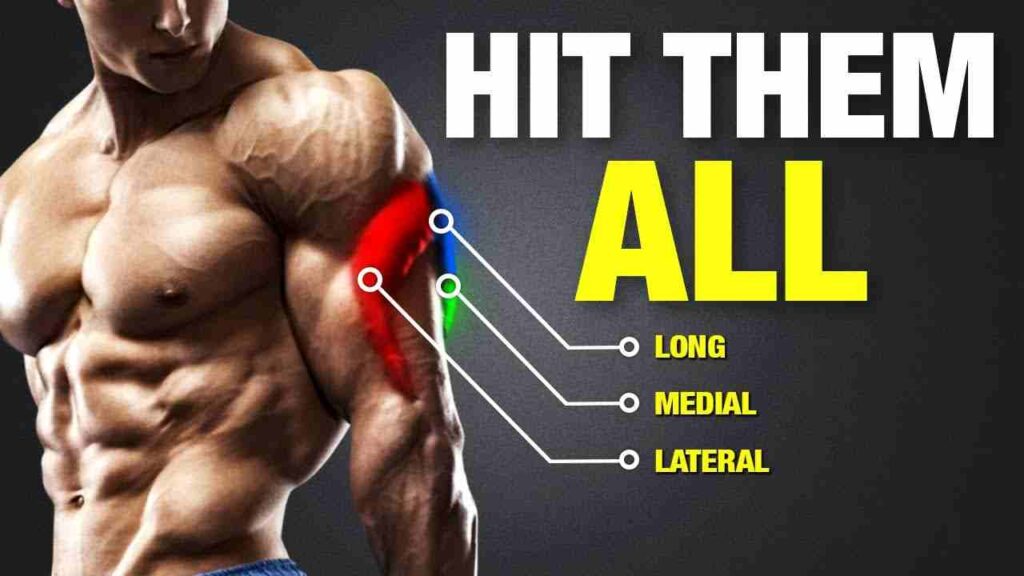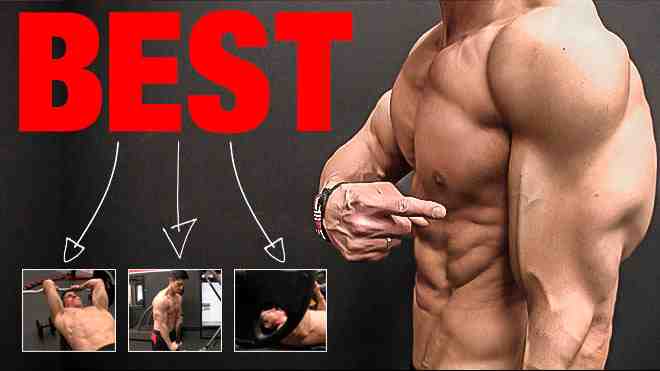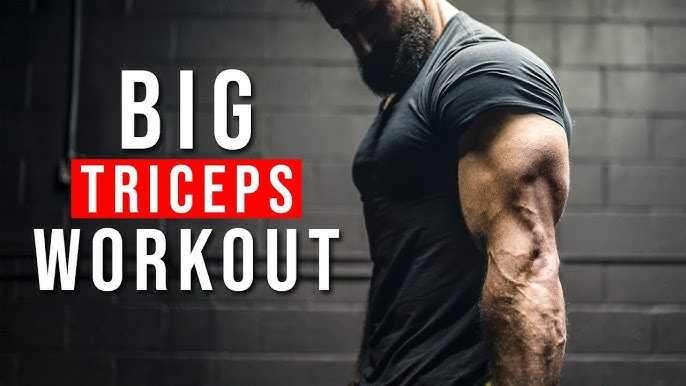Have you ever wondered why, despite your consistent workouts, your triceps don’t seem to be growing as you’d like? You’re not alone. Many fitness enthusiasts struggle with the same issue, particularly when it comes to the lateral head tricep. This part of the muscle plays a crucial role in both the functionality and aesthetics of your arms. Yet, it often lags behind in development.
SHOP FOR THE ADJUSTABLE DUMBBELL SET ON AMAZON
In this article, we’ll delve into the anatomy of the triceps, the importance of the lateral head, and why it might not be growing as expected. We’ll also share effective exercises and tips to help you overcome these challenges and achieve well-rounded tricep development. So, let’s dive in and arm ourselves with knowledge!
Tricep Muscle Anatomy
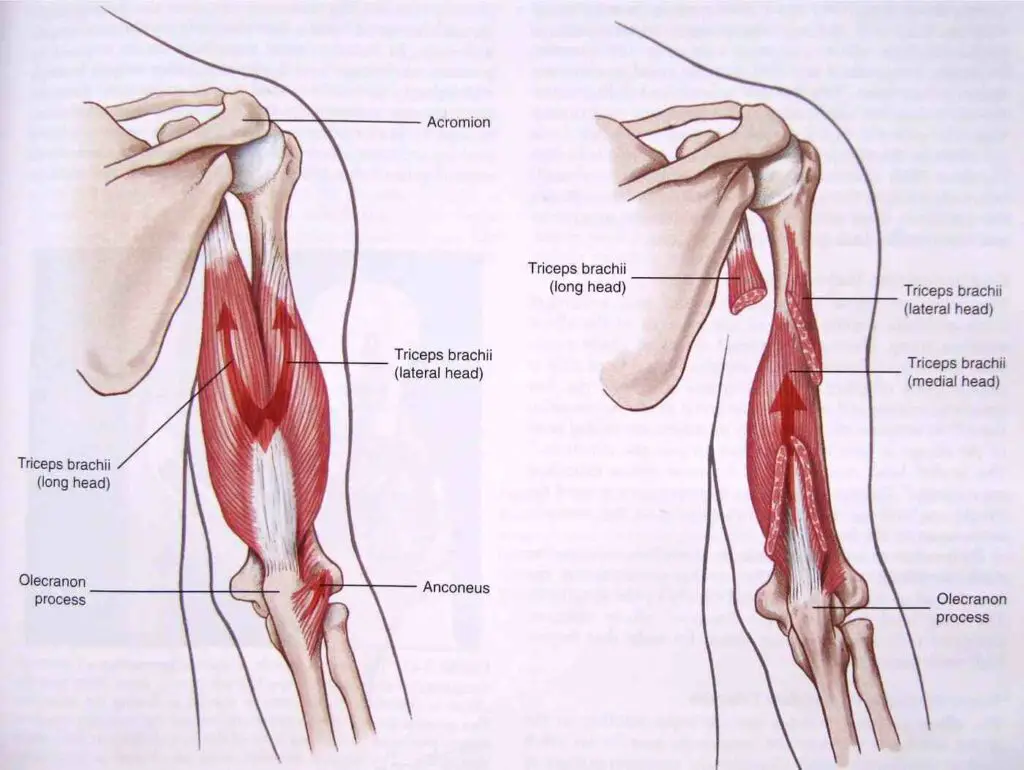
The triceps brachii is a large, thick muscle located on the dorsal part of the upper arm, responsible for the extension of the elbow joint. The muscle is composed of three heads: the long head, the lateral head, and the medial head. Each head has different origins but converges into a single tendon distally, which attaches to the proximal portion of the olecranon process (the bony prominence of the elbow).
- Long Head: Originates from the infraglenoid tubercle of the scapula. It is mainly supplied by the deep brachial artery and the posterior circumflex humeral artery. The long head is considered to be involved in sustained force generation and synergistic control of the shoulder and elbow.
- Lateral Head: Originates from the humerus, superior to the radial groove. It is innervated by the radial nerve. The lateral head is often targeted in exercises to improve arm development and aesthetics.
- Medial Head: Originates from the humerus, inferior to the radial groove. It is active during extension of the forearm at the elbow joint when the forearm is pronated. The medial head does not attach to the scapula and does not have an action on the glenohumeral joint.
SHOP FOR THE RESISTANCE BAND ON AMAZON
The triceps brachii is antagonized by the biceps brachii muscle and plays a crucial role in fine movements, such as writing, by fixing the elbow joint.
Importance of the Lateral Head
The lateral head is one of the three heads of the triceps brachii muscle, which is located on the back side of the upper arm. The lateral head originates at the posterior aspect of the humerus, superior to the radial groove, and inserts into the posterior surface of the olecranon process of the ulna.
The lateral head of the triceps is crucial for achieving well-rounded arm development, both in terms of aesthetics and functionality. It contributes significantly to the overall arm strength, enhancing performance in pushing movements such as bench presses and push-ups. When sufficiently developed, the lateral head of the triceps provides curvature to the upper arm, giving it a fuller and more impressive look.
Targeting this area with specific exercises can make a significant difference in the appearance of the arms. It’s important to prioritize the lateral head tricep in your workout routine by including different exercises like kickbacks or overhand-grip press downs.
SHOP FOR THE PROTEIN SUPPLEMENT ON AMAZON
Additionally, the overhead position is where lateral head training is maximized, and research shows that the lateral head grows 1.4 times greater using the overhead triceps extension compared to the triceps pushdown. Therefore, incorporating exercises that specifically target the lateral head of the triceps and understanding the impact of shoulder position on muscle activation is essential for maximizing triceps development.
Lateral Head Tricep Exercises
To target the lateral head of the tricep, you need to perform exercises that involve elbow extension with your arms close to your body or slightly in front of you. Some of the best lateral head tricep exercises are:
Close grip bench press
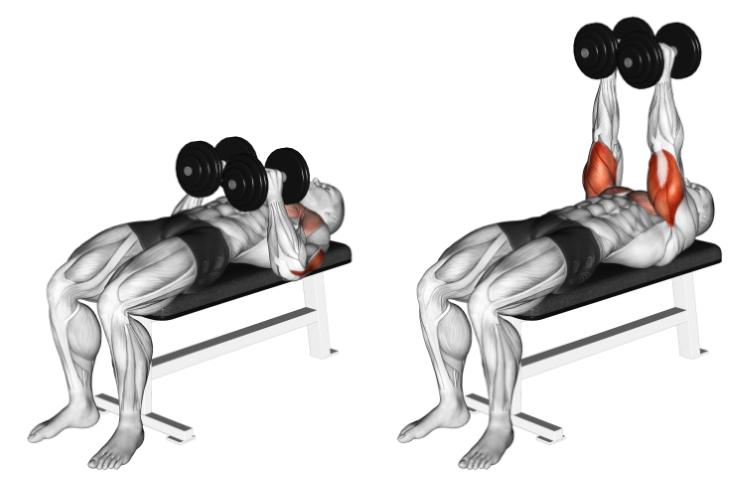
This exercise involves pressing a barbell with a narrow grip, which activates the lateral head more than a regular bench press. You can perform this exercise on a flat, incline, or decline bench.
Tricep press downs
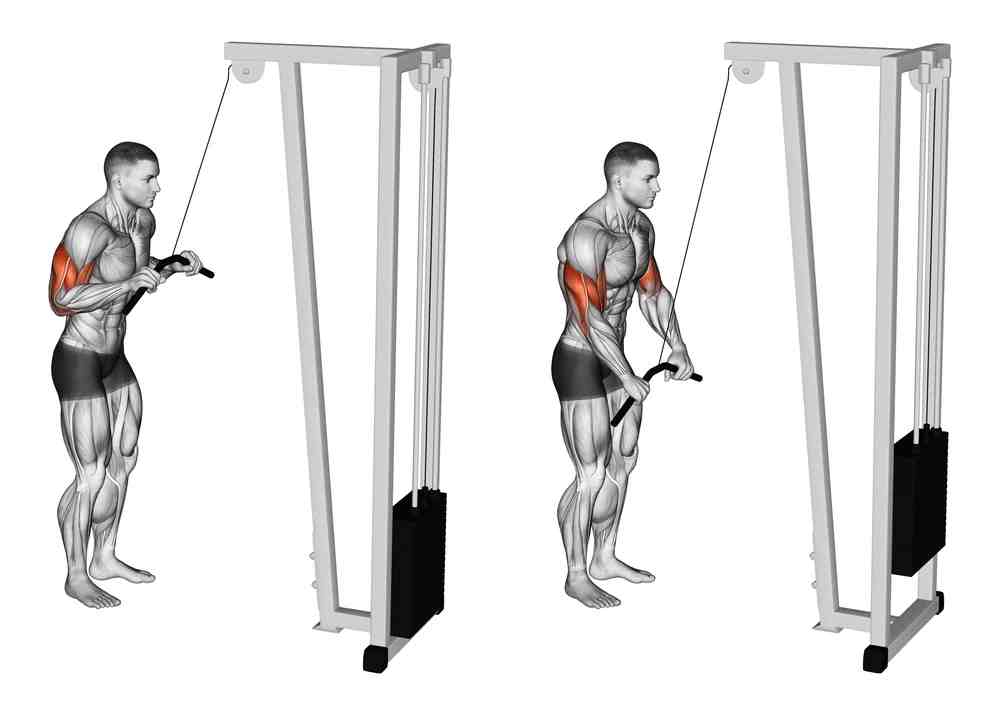
This exercise involves pushing a cable or a band down with your elbows locked by your sides. You can use different attachments, such as a rope, a straight bar, or a V-bar, to vary the stimulus on the lateral head.
Diamond push-ups

This exercise involves doing push-ups with your hands close together, forming a diamond shape with your thumbs and index fingers. This places more emphasis on the triceps, especially the lateral head, than regular push-ups.
EZ bar skull crushers
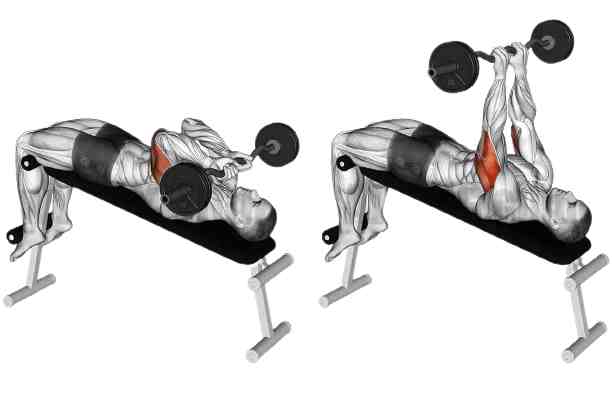
This exercise involves lying on a bench and extending a barbell with a curved grip over your head. The EZ bar allows you to keep your wrists in a more comfortable position and isolate the lateral head better than a straight bar.
Dumbbell French press
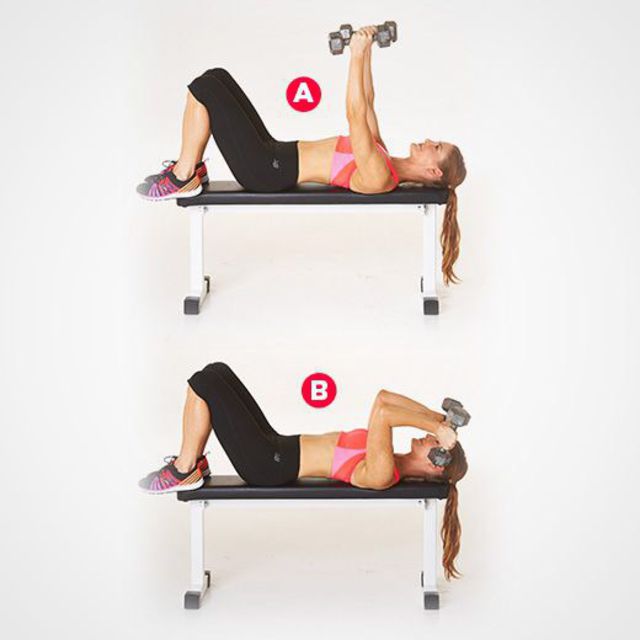
This exercise involves lying on a bench and extending a dumbbell over your head with both hands. You can also do this exercise standing or seated, as long as you keep your elbows close to your ears and your upper arms stationary.
SHOP FOR THE FOAM ROLLER ON AMAZON
These are some of the most effective exercises for the lateral head of the triceps. You can include them in your workout routine to improve your arm strength, size, and appearance.
Training Strategies
Here are some training strategies to target the lateral head tricep and build bigger arms:
- Prioritize Triceps in Your Training: Prioritize the triceps in your training routine and include different exercises like kickbacks or overhand-grip pressdowns to target the lateral head tricep.
- Include Lateral Head Movements: Incorporate lateral head movements in your triceps workout, such as dips, kickbacks, and overhand-grip press-downs, which are all good choices for targeting the lateral head.
- Increase Triceps Training Volume: To maximize growth in the lateral head tricep, increase your triceps training volume by adding a second triceps workout each week.
- Use Multijoint Movements: Use multijoint movements like close-grip bench press and dips to target the lateral head tricep.
- Vary Shoulder Position: Shoulder position heavily influences the contribution of each muscle head, so use a range of shoulder angles to maximize triceps development.
- Pay Attention to Form: Proper form is essential to effectively target the lateral head tricep, so make sure to pay attention to form and technique.
By incorporating these training strategies into your workout routine, you can effectively target the lateral head tricep and build bigger arms.
Training Volume for Tricep Growth
Training volume is a crucial factor in muscle growth, including the triceps. It refers to the total amount of work done for a particular muscle group during a training period. This can be calculated in two ways:
- Pounds lifted per movement pattern per week: This is calculated as the number of sets multiplied by the number of reps and the weight lifted. For example, if you bench press 225 pounds for 10 sets of 5 reps, your weekly bench press volume is 11,250 pounds.
- Number of hard sets per muscle group per week: For instance, if you do 5 challenging sets of bench presses on Monday and Friday, the volume for your chest is 10 sets per week.
For general growth of the triceps, you might want to aim for 10-15 total work sets per week. If you’re not seeing growth, you could increase this to 15-20 sets. If growth is still lacking, you could even go up to 20-25 total weekly work sets, as long as you spread out that volume across 2-3 days.
SHOP FOR THE FITNESS TRACKER ON AMAZON
However, the optimal triceps volume varies individually. Some people benefit from a lower rep range with 8+ and others even need 15-20 reps. It’s important to listen to your body and adjust your training volume accordingly to avoid overtraining and promote muscle growth.
Remember, the key to muscle growth is not just about the volume but also about the intensity of your workouts and your nutrition. Always ensure you’re eating enough protein and calories to support muscle growth.
Why Isn’t My Lateral Head Tricep Growing?
If you’ve been putting in the effort at the gym but haven’t seen the growth you desire in your lateral head triceps, several factors could be at play. Identifying and addressing these issues can help you overcome plateaus and promote muscle development. Here are some common reasons why your lateral head triceps might not be growing:
1. Imbalanced Training: Ensure that your triceps training program is well-rounded and doesn’t overly prioritize one head over the others. Include exercises that specifically target the lateral head.
2. Inadequate Exercise Selection: If your triceps workouts focus primarily on compound movements, you may not be adequately isolating the lateral head. Include isolation exercises like triceps kickbacks or cable lateral raises.
3. Improper Form: Check your form during triceps exercises. Incomplete range of motion can limit muscle activation. Perform exercises through a full range of motion to maximize muscle engagement.
4. Lack of Progressive Overload: Ensure that you’re progressively increasing the resistance or intensity of your workouts over time. Without this progression, your muscles won’t be sufficiently challenged to grow.
5. Insufficient Volume: Evaluate your workout frequency and volume. Training the triceps only sporadically or with insufficient volume may impede growth.
6. Poor Nutrition: Protein is essential for muscle growth. Ensure you’re consuming enough protein to support the repair and growth of your triceps muscles.
7. Inadequate Recovery: Muscles need time to recover and grow. Overtraining or inadequate rest can hinder progress. Ensure you’re getting enough sleep and allowing for proper recovery between workouts.
8. Genetic Factors: Genetics can play a role in muscle development. Some individuals may naturally find certain areas harder to grow. Be patient and focus on optimizing what you can control.
9. Consistency Issues: Building muscle takes time and consistency. If you’ve been inconsistent with your workouts, it can impede progress. Stick to a regular and well-structured training routine.
10. Medical Considerations: Address any existing injuries or imbalances that may affect your triceps training. Consult with a healthcare professional or a fitness expert if needed.
Effective Home Dumbbell Tricep Workout
By addressing these potential issues, you can develop a more targeted and effective triceps training program. Remember that consistency, patience, and a holistic approach to training, nutrition, and recovery are key to achieving muscle growth in any specific muscle group, including the lateral head of the triceps.
Nutrition and Recovery for Tricep Growth
Nutrition and recovery are two important factors for tricep growth, as well as for any muscle group. Here are some tips on how to optimize your nutrition and recovery for tricep growth:
- Nutrition: To build muscle, you must consume enough calories and protein to support your training and recovery. A general guideline is to eat around 0.8-1.2 grams of protein per pound of body weight per day, and to eat at a slight caloric surplus of around 250-500 calories above your maintenance level. You should also include healthy sources of carbohydrates and fats in your diet, as they provide energy, hormones, and micronutrients for your body. Some examples of good foods for tricep growth are lean meats, eggs, dairy, fish, nuts, seeds, beans, whole grains, fruits, and vegetables.
- Recovery: To recover from your tricep workouts, you need to rest and sleep enough to allow your muscles to repair and grow. A general guideline is to sleep for 7-9 hours per night, and to take at least 48 hours between tricep sessions. You should also avoid overtraining, which can impair your performance and hinder your progress. Some signs of overtraining are fatigue, soreness, loss of appetite, mood swings, insomnia, and decreased strength. To prevent overtraining, you should vary your intensity and volume, listen to your body, and take deload weeks when needed.
Incline Dumbbell Tricep Extension
By following these tips, you can improve your nutrition and recovery for tricep growth, and achieve bigger and stronger arms.
Genetic and Hormonal Factors that Could Influence Muscle Development
Muscle development is influenced by both genetic and environmental factors. Some of the individual variations that could affect muscle growth are:
- Genetic variations: Many genes are involved in muscle growth, such as those that code for hormones, growth factors, receptors, enzymes, and structural proteins. Some of these genes can have different variants or polymorphisms that can affect how the muscle responds to exercise, nutrition, and injury. For example, the gene ACTN3, which codes for a protein found in fast-twitch muscle fibers, has two common variants: R and X. The R variant is associated with more power and strength, while the X variant is linked to more endurance and fatigue resistance. Depending on the combination of these variants, individuals may have different potentials for muscle development and performance.
- Hormonal levels: Hormones are chemical messengers that regulate various processes in the body, including muscle growth. Some of the most important hormones for muscle development are testosterone, growth hormone, insulin-like growth factor 1 (IGF-1), and cortisol. Testosterone and growth hormone stimulate muscle protein synthesis and hypertrophy, while IGF-1 enhances muscle cell proliferation and differentiation. Cortisol, on the other hand, is a stress hormone that can have negative effects on muscle growth, such as increasing muscle protein breakdown and inhibiting muscle protein synthesis. Hormonal levels can vary among individuals due to genetic, age, gender, and environmental factors, such as diet, sleep, and stress.
Periodization for Tricep Growth
Periodization is a method of organizing your training into different phases or cycles, each with a specific goal and intensity. Periodization can help you optimize your tricep growth by preventing plateaus, overtraining, and boredom, as well as enhancing your strength, power, and endurance.
There are three main types of periodization: linear, undulating, and block. Here is a brief overview of each one and how they can benefit your tricep development:
- Linear periodization: This is the simplest and most common type of periodization, where you gradually increase the weight and decrease the reps over time. For example, you may start with 4 sets of 12 reps at 60% of your one-rep max (1RM) in the first week, and end with 4 sets of 4 reps at 90% of your 1RM in the last week. This type of periodization is good for building strength and muscle mass, as well as preparing you for heavier loads in the future.
- Undulating periodization: This is a more flexible and varied type of periodization, where you change the weight, reps, and sets within the same week or even the same session. For example, you may do 3 sets of 8 reps at 80% of your 1RM on Monday, 4 sets of 15 reps at 50% of your 1RM on Wednesday, and 5 sets of 5 reps at 85% of your 1RM on Friday. This type of periodization is good for stimulating different muscle fibers and energy systems, as well as avoiding adaptation and boredom.
- Block periodization: This is a more advanced and complex type of periodization, where you divide your training into blocks of 2-6 weeks, each with a different focus and intensity. For example, you may do a hypertrophy block, where you focus on high volume and moderate weight, followed by a strength block, where you focus on low volume and high weight, followed by a power block, where you focus on explosive movements and speed. This type of periodization is good for maximizing your performance and peaking for a specific event or goal.
SHOP FOR THE PRE-WORKOUT POWDER ON AMAZON
To use periodization for tricep growth, you should choose the type that suits your goals, experience, and preferences. You should also consider your recovery, nutrition, and other factors that affect your muscle growth. Periodization can help you plan your tricep training more effectively and efficiently, and achieve bigger and stronger arms.
FAQs
Q 1: How do I know if I’m targeting the lateral head during triceps exercises?
Ans: Focus on feeling the contraction in the lateral head during exercises. Ensure proper form and consider incorporating exercises that specifically target this area, such as overhead triceps extensions.
Q 2: Should I incorporate drop sets or other intensity techniques for better triceps growth?
Ans: Intensity techniques like drop sets can be effective for muscle growth. However, it’s essential to incorporate them strategically and not overuse them to avoid overtraining.
Q 3: Are there any signs that I might be overtraining my triceps?
Ans: Yes, signs of overtraining can include persistent fatigue, decreased performance, and increased susceptibility to injuries. Ensure you allow sufficient time for recovery between triceps workouts.
Q 4: Are there any specific stretches or warm-up exercises that target the lateral head of the triceps?
Ans: Yes, incorporating dynamic stretches and warm-up sets for triceps before your workout can help improve blood flow and flexibility, potentially enhancing the effectiveness of your workout.
Conclusion
In conclusion, the growth of the lateral head of the triceps, like any other muscle, is influenced by a variety of factors. These include the right training techniques, adequate nutrition, sufficient recovery, and even genetic factors. It’s important to remember that everyone’s body responds differently to exercise and diet, so what works for one person may not work for another.
Therefore, it’s crucial to listen to your body, adjust your training and nutrition accordingly, and consult with fitness professionals when necessary. By doing so, you can maximize your muscle growth and achieve your fitness goals. Remember, consistency is key in any fitness journey. Keep pushing, stay motivated, and you’ll see progress over time. Happy training!

Good day, and welcome to Fitthour. My name is Shubham Vijay, and I am a certified personal trainer and nutrition coach with 6 years of experience in the fitness industry. At Fitthour, we specialize in types of training, such as strength training, cardio, or HIIT, and our mission is to help clients achieve their fitness goals and improve their overall health.

